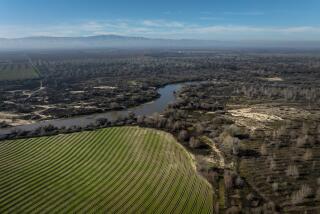Ventura River Presents Tough Safety Problem in Storm, Officials Say
The flash-flooding of the Ventura River that inundated a recreational vehicle park during February’s storms probably could have been prevented by paving the waterway, many experts agree.
And clearing the vegetation in the river also might have lessened the chance that the river would fill its channel and jump its banks, they add.
But scientists and government officials say that even the most extreme measures could not have guaranteed protection in a storm as intense as the Feb. 12 rain that hit the already-saturated Ventura River watershed with nearly an inch of rainfall per hour for five hours.
Moreover, replacing natural river systems with concrete has not been an option to control floods in most cases since the advent of environmental awareness and state and federal regulations during the 1960s.
Strict protection laws including the federal Clean Water Act and the Endangered Species Act passed during the 1970s prohibit officials from clearing the river of vegetation if such action would disturb wetlands or the endangered species that thrive in the riverbed and its banks.
State and federal regulators say those consequences would be inevitable if vegetation were uprooted.
In addition, removing the river’s islands of reeds and willows would also be expensive--possibly prohibitively so during tough economic times--and would probably have to be repeated every year, Ventura County Public Works officials said.
A better option, officials said, is to let nature do the work for them, cleaning out the channel with a periodic sweep of flood waters.
Arnold Hubbard, owner of the Ventura Beach RV Resort, acknowledged that there are risks in building where he did, in a portion of the river bottom designated as flood plain.
But Hubbard said he believes that damage to his property could have been avoided if the riverbed had been cleared of brush and trees. The Ventura County Flood Control Department should protect his development against floods just as the Police Department protects it against crime, he said.
“The environmentalists say we don’t want to disturb animal life and plants in the river,” he said. “But if those things are so important that we want to spend money to preserve them, then maybe we should declare the area a park and build a flood channel alongside it so water can go down without disrupting people’s lives and property.”
Federal, state and local officials say, however, that the least expensive and only fail-safe way to protect life and property from floods is to keep development out of the river’s historic channels and flood plain.
“The developer who claims the river should be cleared is just trying to cover his own butt,” said Cathy Brown, a U.S. Fish and Wildlife Service biologist. “He was warned repeatedly that he was proposing a development in the flood way of a river. It’s still a dynamic natural river with tremendous value to the ecosystem and the endangered species that depend on the estuary.”
“He is not entitled to protection,” said Alex Sheydayi, director of Ventura County Public Works Agency. “We don’t protect people who intentionally build in the river bottom.”
The debate in the aftermath of the flood, which claimed the life of a homeless man who camped in the river bottom and threatened more than 100 other homeless people and RV park residents, pits a developer and his allies against public works officials, scientists and preservationists.
The dispute was sparked early on the morning of Feb. 12. After a week of back-to-back storms that saturated much of the 226-mile watershed of the Ventura River, the area received 4.35 inches from 2 a.m. to 7 a.m.
The Ventura River, which is dry most months except for flow added by a sewage-treatment plant about three miles north of Ventura, became a deadly, swift torrent that carried sediment, brush and rocks from its headwaters above Matilija Dam 16 miles to the sea.
When the surging water reached Foster Park, it ran into the levee on the river’s east bank built by the Army Corps of Engineers in 1948 to protect the homes in Ventura’s northwest end. With no outlet to the east, the racing river bounced west and topped its banks, fanning out as the river reached its mouth at the ocean.
The flood waters spread over an agricultural field, topped the Ventura Freeway and inundated the RV park, where owners of 57 trailers and motor homes fled for safety. County search and rescue workers in helicopters and Hovercraft rescued 35 people and their pets from the park and the river bottom.
Dolores Taylor, Ventura County hydrologist and engineer, estimated that the brush and vegetation combined with moving sediment and rocks made up about 40% of the river’s bulk. Much of it was carried down from the headwaters of the river, she said.
Taylor said the river did what it was supposed to do in carrying sediment and brush downriver and out to sea. But she said some of the brush on its way down the river got hung up on vegetation downstream from the Ojai Valley Sanitation District sewage treatment plant that sits near Canada Larga Road.
“The majority of the heavy growth is below the sanitation plant where there is a constant nutrient-rich flow discharged,” Taylor said. If that growth could have been removed, she said, the river might not have jumped its banks.
A row of eucalyptus trees along the river’s west side and a chain-link fence surrounding farmland north of Hubbard’s property that was mowed down by the river’s force also created obstacles to the river’s course and acted as a debris-catcher to block the flow, officials said.
But Edward Keller, chairman of environmental studies and professor of geological sciences at UC Santa Barbara, said that brush in the river was not the cause of the flooding.
Flooding is a natural phenomenon that occurs periodically as the river continually fills its channel with sediment on its way to the sea and then seeks lower ground to continue its flow. The slopes are steep in the headwaters of the river, contributing tremendous force to the flow, he said.
People who camp at the park during winter months, when flooding is expected, could be risking their lives, Keller said.
“Every time I drove by that park, I thought it was a disaster waiting to happen,” he said. “They are lucky more people weren’t killed.”
But Hubbard, backed by Ventura City Councilman James Monahan and members of the Ventura County Fair board of directors, said something should be done to prevent a recurrence of the flood.
Although officials say no one in Ventura County is advocating that the river be paved, Donald F. Nichols, assistant deputy director of the Los Angeles County Department of Public Works, said the 40-mile concrete channel that is the Los Angeles River performed well during the latest storm.
“The concrete channel allows folks to live near the channel and prevents overflow,” he said. Although biologists now point to the Los Angeles River as an environmental disaster and some environmentalists now advocate dismantling the concrete, Nichols said he would ask the Army Corps of Engineers to build it now if it hadn’t been built more than 40 years ago.
“It was some of the best public dollars ever spent,” he said.
The Ventura County Fairgrounds, just east of the river mouth, were not affected by the Feb. 12 flood or any other flood since the Army Corps of Engineers levee was built 44 years ago.
But Michael D. LeBeck, chairman of the fair board, said fair directors fear a flash flood could hit fair property the next time the river floods.
“We’re protected by a levee, but what if the levee broke?” he said. “We don’t want this flooding to happen again.” Nevertheless, the history of the river is one that suggests flooding will recur and with relatively predictable frequency.
The RV park is in an area designated as a 100-year flood plain, which means that, based on historical data that shows the plain would be flooded on average once every 100 years, scientists calculate there is a 1% chance that it could be flooded in any given year.
The Feb. 12 storm produced runoff of such intensity that it is classified as a 50-year event, which has a 2% chance of occurring in any year and a 10% chance of occurring within five years.
But Brown said there were two major floods within a month of each other in 1969. “So no one should take comfort in thinking we probably won’t have another one before 50 years,” she said.
Mark Capelli, a biologist and lecturer on coastal processes at UC Santa Barbara and a member of the Friends of the Ventura River, said the events of Feb. 12 should be seen not as a flood-control problem but as a historic event.
“We’ve heard lots about wetlands being destroyed,” he said. “But on Feb. 12, we saw Mother Nature making and remaking wetlands and creating a delta. We were witness to a tremendous physical process.”
Keller said it is a system that should be left alone and respected.
“You have to recognize that the river and a flood plain are part of the same system operating together in harmony,” said Keller, who is preparing a research paper on the event. “Any time you try to disrupt that harmony, you’re asking for trouble.”
Major County Floods
There have been five major floods of the Ventura River since 1938, their seriousness measured in the amount of cubic feet of water flowing down the flood channel per second (cfs).
Amount of Year Date water (cfs) Storm event 1938 March 2 39,200 cfs 10-year event 1969 Jan. 25 58,000 cfs 50-year event 1969 Feb. 25 40,000 cfs 10-year event 1978 Feb. 10 63,000 cfs 50-year event 1992 Feb. 12 58,000 cfs 50-year event
A 50-year storm is one that has occurred on average historically once every 50 years. However, there is a 2% chance that it will occur in any given year. There is a 10% chance that a 10-year storm will occur in any given year.
A cubic foot of water is about 7.5 gallons. A fire hydrant with its valve fully open gushes at the rate of about 1 cubic foot per second.
Source: Ventura County Flood Control
More to Read
Sign up for Essential California
The most important California stories and recommendations in your inbox every morning.
You may occasionally receive promotional content from the Los Angeles Times.










